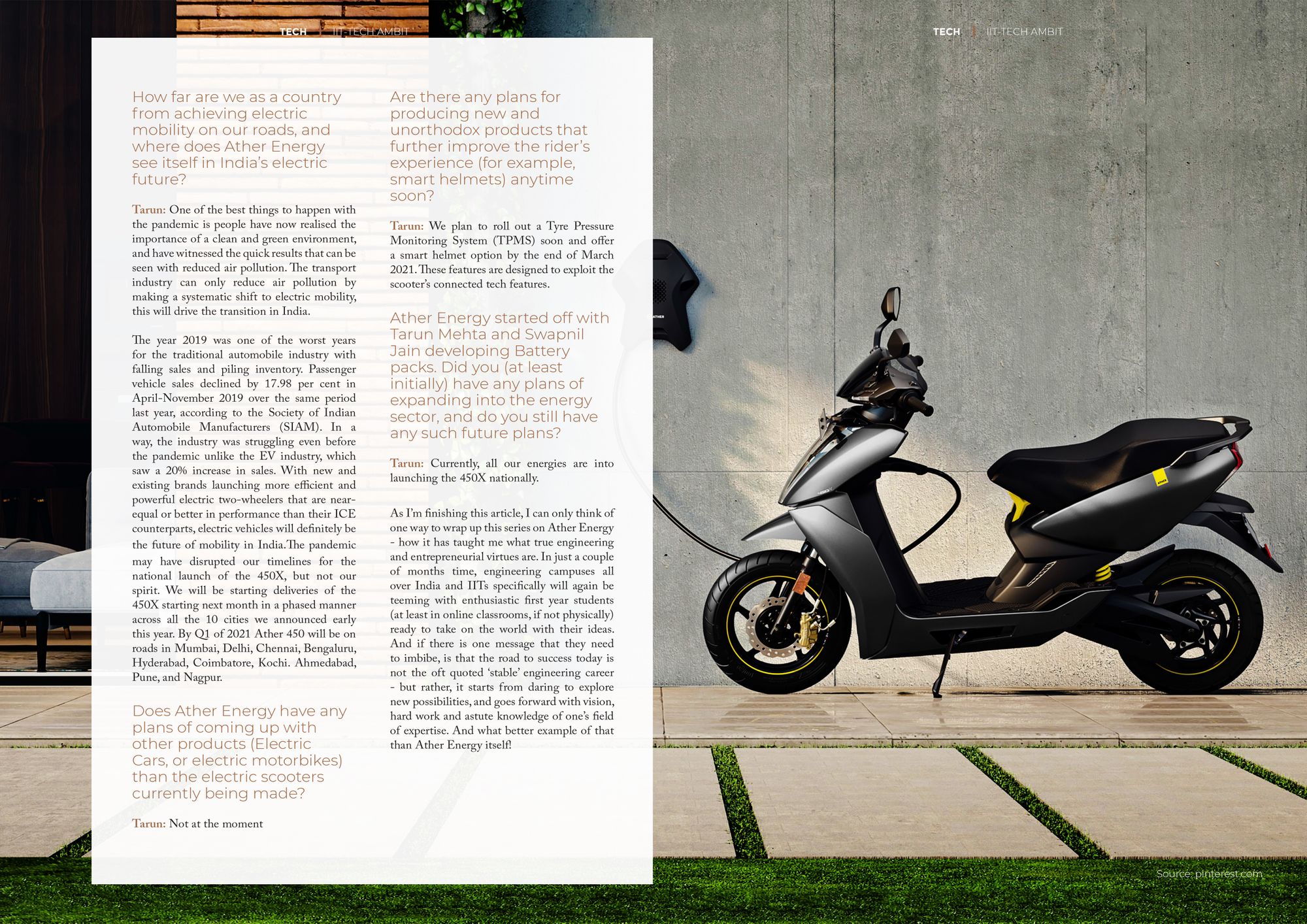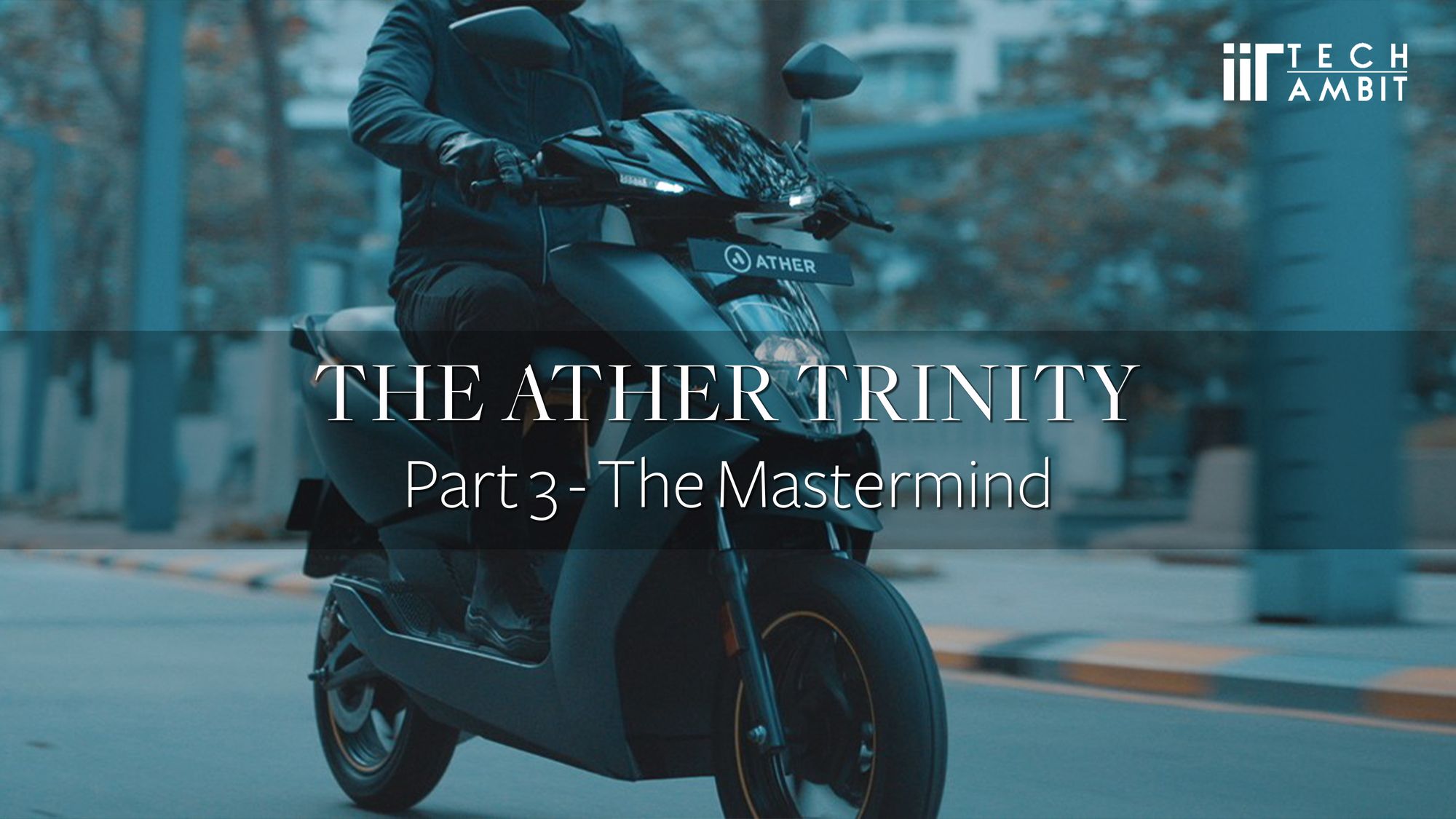Electric Vehicles will be the go-to mode of transport in the near future - it’s efficient, clean - and thanks to Ather Energy, now it's smart and fast as well (Read the first and second articles in the series to convince yourself about this). After starting off with a small idea of swappable battery packs, Ather Energy has now become a front runner in producing smart electric scooters in India. As a tech startup, the journey of Ather Energy was not facile at all. Tarun Mehta and Swapnil Jain’s startup was in one of the earlier batches incubated at the Research Park of IIT Madras. Mehta recalls the support of R. Krishna Kumar, a professor at the Department of Engineering Design at IIT-Madras.
“If a professor says, ‘Leave your job and come back; we will take care of everything,’ I think that is a great morale boost,” says the Ather CEO, “For the first five-six months, we literally camped out of the department. We were just hanging around in his labs and other department labs before we sort of reached a conclusion that ‘This seems interesting and we should actually start a company and build a product.’ It was a very important phase and he was super supportive then.”
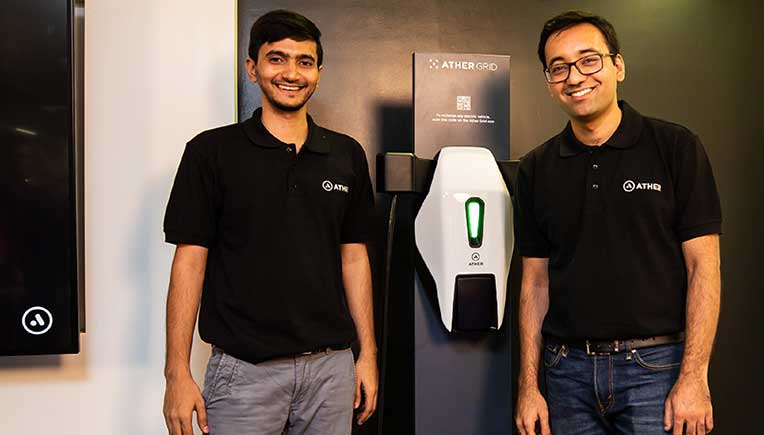
The idea (now a reality) of an indigenous top notch electric scooter with the best of parameters is more than just the ultimate fancy of the atma nirbhar Indian consumer - Ather Energy’s rise is that of an engineering startup that dared to rethink the traditional rules of the automobile industry and started out with fresh ideas - a lesson truly pertinent to those who find themselves at the place where Swapnil and Tarun were in their first year at IIT Madras. Here we have Tarun Mehta, CEO and Co-Founder of Ather Energy who will walk us through the early-stage development of his startup.
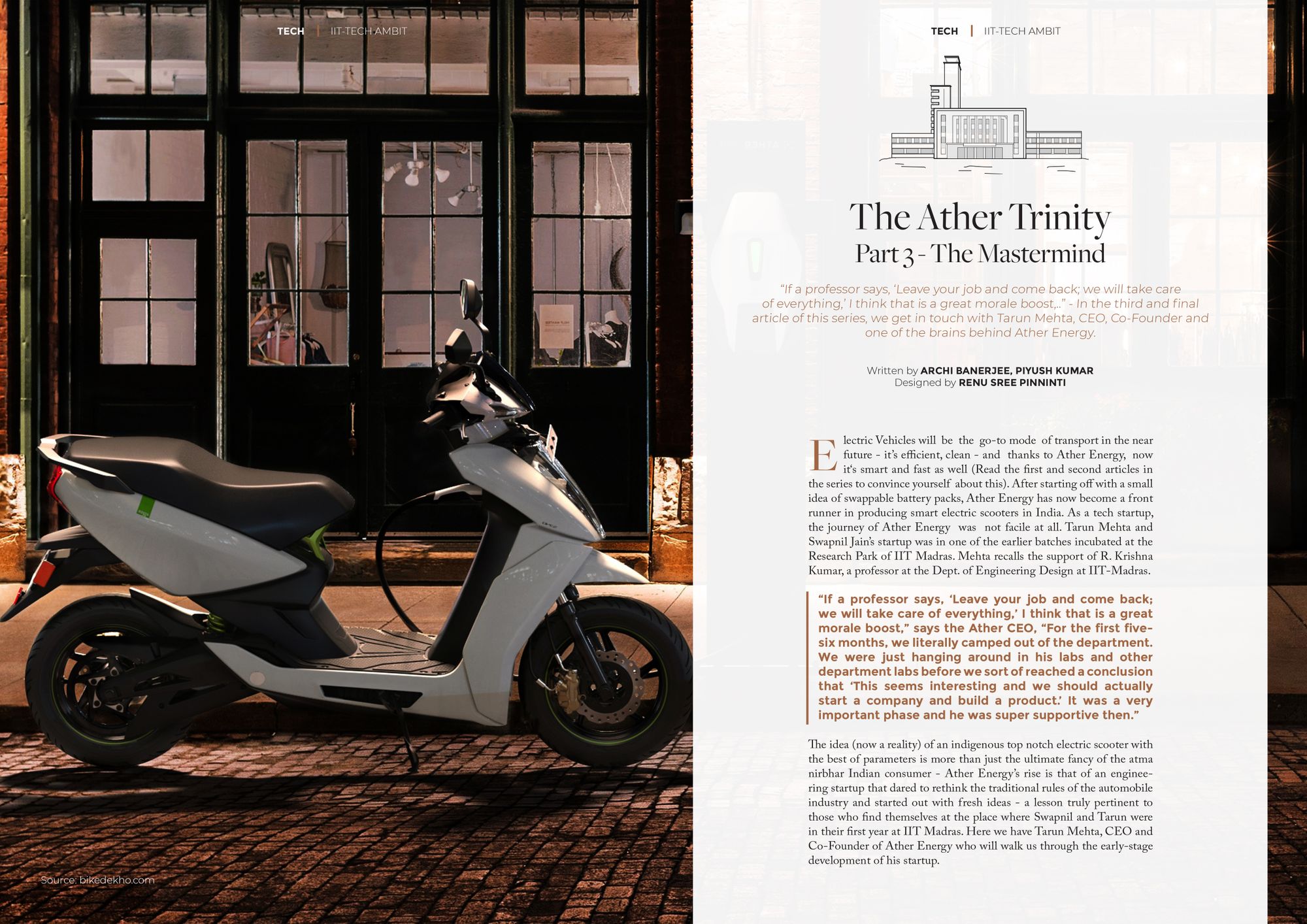
IIT Madras & Ather’s beginnings:
How has the company benefited from the middle ground between industry and academia that the incubation period at IIT Madras provided?
Tarun: I think the biggest benefit of starting from the campus was the cocoon that it provided. Being amidst a lot of startups and being amidst enterprises has values, but there is an unsaid value of being in a place like the campus. The Research Park gives you time to develop your idea. It gives you time to iterate and form a long-term vision without getting too distracted. One of the biggest problems of being close to other startups or industries is that you tend to pivot a lot. Starting up at a place like the IIT-M campus allows you the space to form enough opinions so you don't pivot a lot. And actually, that's pretty much what I would say was the benefit of being at IIT when at the beginning. We were not exactly in the middle of industry and academia as much as we were in a really nice sheltered place for the first year.
How is the startup scenario at IIT Madras? Do you see more such engineering startups coming up from IIT Madras’s Research Park?
Tarun: We were one of the earlier batches to have taken incubation at the Research Park. But since then, now, the Research Park and the campus at large have been living up to the reputation of producing a lot of tech, hardware, and deep tech startups. IIT Madras probably has the best reputation in the country. Most of the startups that have come out are still early stage so we don't hear as much about them. But honestly, for any early-stage VC or investor looking for the fountain of deep tech or hardware startups, it has got to be the starting point today. I will give a lot of credit to the foresight of the Institute and several departments (engineering design, biotech, etc.) and several initiatives like the CSI Center for Innovation and Entrepreneurship Cell, which I believe led to a lot of startups coming out of IIT. There is also an increase in the participation from professors directly as co-founders of more and more startups. That's an extremely healthy trend, one that I hope will continue and accelerate.

Ather Energy is a brilliant example of how engineering along with innovative ideas can provide solutions to major problems. As alumni of IIT Madras, how far do you think IIT Madras and the Department of Engineering Design in particular, try to inculcate that spirit? Are the courses designed in such a manner that it also engages and builds a student’s ability to think out of the box?
Tarun: I think we were in a very interesting time on the campus when Swapnil and I joined in 2007. And it was a fantastic time because the Center for Innovation, Entrepreneurship Cell, and FSAE Project was just about starting up. A lot of the startups that came out in the 2011-13 period were by people who were extremely active in these initiatives.
It was also an interesting time in that the Department of Engineering Design was just getting started. We felt that we were actually involved in the building of the department, we were the third batch. I do think that the department of engine design does have more openness and opens up more opportunities for people to think of starting up. At least back in our time, there was a lot of conversation not just on the theory but on physical projects. And not just physical prototypes, there was a lot of conversation around understanding the entire journey of taking an idea to a product. So we had courses from the Management Studies Department, by Prof. L S Ganesh. We had courses within the department, where we ended up pitching the complete project, right from the cost of the prototype, to the development cost, to the multiple stages required to convert into a product. Obviously, the real industry and an actual startup are very different. But just the fact that courses are designed to make us think about all of this was extremely helpful. I also give a lot of credit to the professors. Even when we started up, we were literally camping out of the department. Professors like Sandipan Bandopadhyay, our Professor RKK (Professor R Krishna Kumar), and many others were extremely supportive. I remember when we wanted to start up, we just went and told Prof RKK that we want to leave our jobs because we want to start building electric vehicles. And his response was, “First leave your job”. And I think that's amazing to hear from a professor. That it will be great if you just leave your job first. And because you want to build something, come back to the campus and come back to the department. And obviously the department was very supportive. So it's a lot of small things that added up. Whether the courses are designed to encourage the students’ ability to think out-of-the-box, I'm not sure. But yes, some sections of it are. I do see a constant journey at the department level to try and get better at it. So I'm hopeful that we could have an ideal course structure in the coming few years.

When you were at IIT Madras, how and what made you realise that it's time for switching to the production stage (as a company) from the incubation and R&D stage?
Tarun: It was the funding. The first money came from an alumnus who was delivering a talk on the campus. And because we were around the campus, we happened to bump into him. We pitched the idea. And we ended up raising ₹25 lakhs from him. That was enough for us to take real office space in the Research Park. But the journey from there to actually thinking of building a real company and not just a small lab, and actually hiring people at any significant scale happened when we raised the first million dollars from Sachin and Binny Bansal. Back in 2014, this was a phenomenal capital to raise for us. We had no plan of what to do with the million dollars back then. So that was the first time and we realized that it's time to move out of thinking like a lab or a small incubated company and actually start thinking as a real company and hire people.
Vehicle Development & Vertical Integration:
Ather is not alone in its bet on electric mobility. There are at least a dozen others in India working day and night to launch electric vehicles on Indian roads. But a key ingredient of what makes them, them, is Ather’s unique vehicle development processes. Unlike other electric vehicle companies, the company itself owns and controls its process, the suppliers, distributions, the whole supply chain - or in industry jargon, their production line is vertically integrated. They brought all of the technology in house and built everything from scratch (apart from the very basic ingredients - like the Li ion battery cell, which has to be imported) and in the process, reduced initial acquisition cost, created better prototypes and products, and also allowed themselves to bring unorthodox features to their product - for example: a Battery Management System (AKA the brain of the vehicle) built entirely by the people at Ather, that helps monitor all the cells, voltage, current, load, and temperature. It helps track the performance of the battery pack on a daily basis, and it has inbuilt algorithms that learn continuously about the usage and performance of its battery packs. We asked them to put up some light on the processes that they have adopted to make Ather scooters happen.

How do people at Ather come up with the initial idea of an electric scooter? What are the motivations at play when the team comes up with a new model?
Tarun: The driving belief for us is that the product has been built for us. Right from the first product that we started building, the S340, the belief has been that we should build something that we ourselves can use. And if we really can use this product, we might find 100 more such people like us. And eventually, this can be the start of a good company. Obviously, now that we’re scaling up, we are thinking beyond just our own selves. But that has been one of the starting ideas, to think of product development. Just build something that you yourself can be a customer to and then build your way from there.
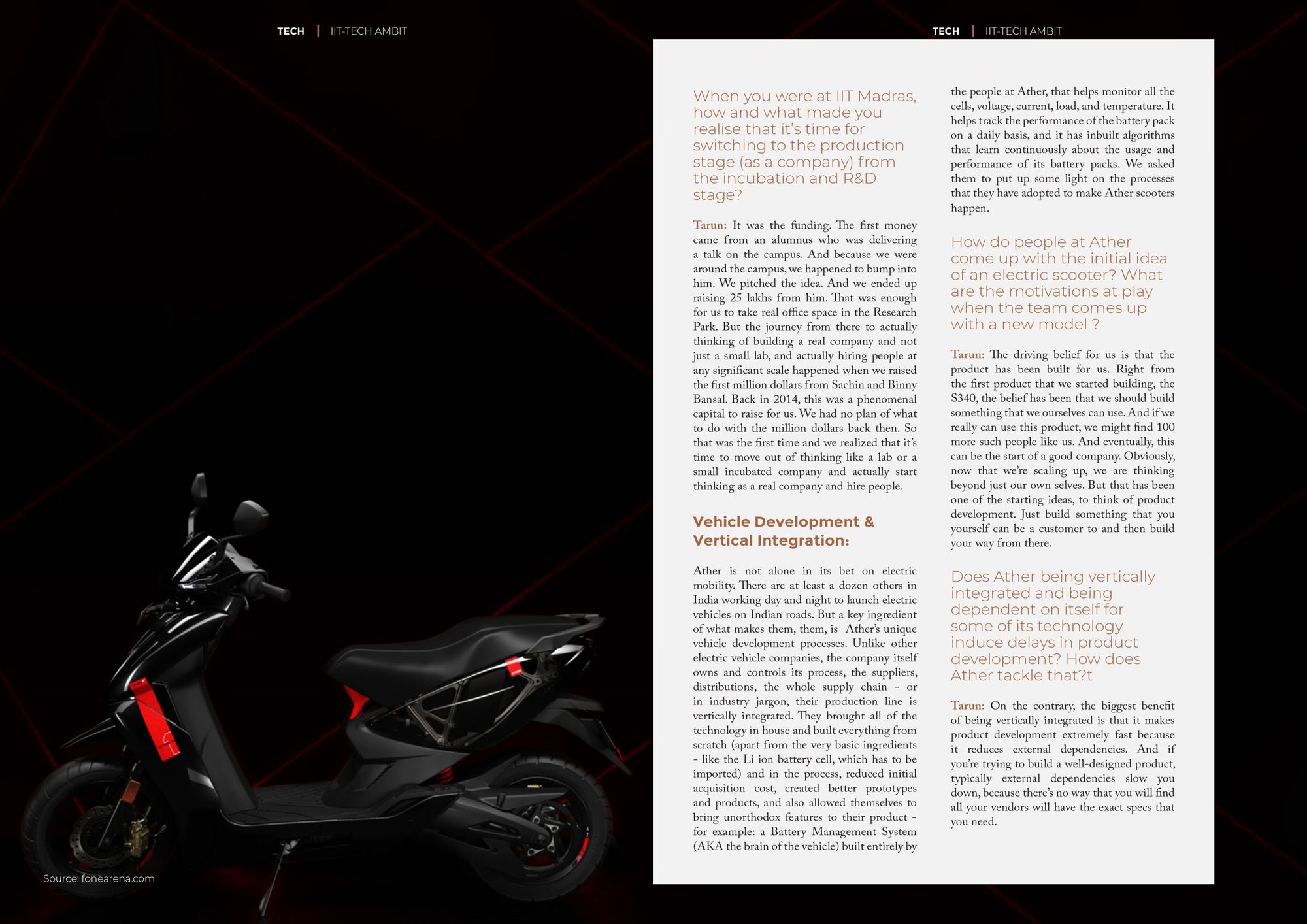
Does Ather being vertically integrated and being dependent on itself for some of its technology induce delays in product development? How does Ather tackle that?
Tarun: On the contrary, the biggest benefit of being vertically integrated is that it makes product development extremely fast because it reduces external dependencies. And if you're trying to build a well-designed product, typically external dependencies slow you down, because there's no way that you will find all your vendors will have the exact specs that you need. And if all of them have to create a spec in line with what you want as a product, it's a very long journey: communication is a nightmare, they may not have the right competency, their timelines will be wildly different, stitching them all up together and then negotiating with them is an incredibly long process. That's part of the reason why nobody built an exciting electric scooter before S340 and 450 rolled out. It was just not considered viable. So being vertically integrated actually gives you a faster timeline if, and only if, you're trying to build a fantastic product. If you’re just trying to build a product being vertically integrated is a slower route, and you're better off taking a lot of things off the shelf and quickly integrating them in the best possible way. It may or may not give you the best spec. And it will certainly make the competition's job very easy because once you demonstrate the integration, it's easy for others to take out the same components and integrate them in a similar way. But it'll give you a much faster timeline. But so it really boils down to what you're trying to do.
MESSI - Making Every Scooter Smart and Intelligent - is a data-collecting device developed by the Ather team to gather more data than what they gather from prototypes and testing teams. MESSI can be plugged and used comfortably with almost all types of existing scooters. With MESSI, essentially a Data Acquisition System, several data types on the scooters are collected in real time from the end user’s experience - throttle, RPM, brake, horn, accelerations, orientations, and location

How has the data collected from MESSI and other such systems helped Ather in developing, debugging and improving their vehicles? What exactly does Ather Energy do with all of the driving data that it collects?
Tarun: So data helps in multiple ways. Firstly, data helps in better product development. As more and more data pours in, you're essentially running a pretty large scale testing of your product, which is impossible to do internally. Today, for example, any automotive company does not have more than a few million kilometres worth of data, on even their old legacy products. Even with a product selling for the last 10-15 years it is very unlikely that any company will have more than a few million kilometres of data on it. On the other hand, in less than two years and barely a few thousand vehicles on the road, we already have 12 million kilometres of data on our own products. And the data quality is extremely high. Information on everything from acceleration, braking, motor performance, battery performance, battery degradation, thermal performance, performance, pack cycling, mechanical response, vibrations, to more software-related ones like when components need servicing, pour back in. And it's extremely, extremely valuable for product design. In the last two years, we've been able to reduce the cost of the vehicle down to half of where we started. And a significant part of it can be attributed to the fact that we just had better data from the field, allowing us to make changes quicker than was otherwise viable. And another way data becomes helpful is it allows us to give people more insights into their own riding patterns, which is extremely interesting, especially for early adopters. And it opens up the opportunity for developers to build new use cases on the back of the data that is already available, increasing the stickiness of the product and its ecosystem.
What are the current problems faced by Ather in their vehicle development process?
Tarun: I'll say the biggest thing that we've been with the building right now is an organization, an engine of an organization that can do product development recurrently and produce a very similar high-quality output every single time. It's one thing to build a product, it's another thing to build a company as a product. So I would say the biggest challenge faced is, converting the product development into an actual process that still continues to produce the same quality every single day.
The Market and the Policies:
India has currently the fourth largest automotive industry in the world which contributes over 45% to the manufacturing sector of the GDP. India has one of the cheapest skilled labour forces in the world, and that could make India a global provider for clean mobility solutions and induce a much-needed spurt in exports. In terms of Government EV policy, while the overall outlook of the Government towards the adoption of electric vehicles has been positive and even ambitious at times, their policy has at times been shaky. Peek here to get an insight into how government policies and rules are affecting the electric vehicle’s industry in India. Read ahead to figure out what people at Ather thinks about the government policies and how they have been affected by COVID-19.

How has the market and EV supply chain logistics been affected by Covid-19? How soon does Ather and the EV industry at large expect to be back on track (both in terms of market demand and supply chain logistics)? Has Covid-19 really delayed the Indian electric vehicle transformation for at least the medium term, or will the industry bounce back quick enough?
Tarun: The lockdown had disrupted the local supply chains and manufacturing, and had also impacted demand in the short term. This disruption will definitely have a strong impact over the next 2-3 quarters, post which we should begin to see the industry starting to get back to pre-COVID levels. In the immediate future, there is an opportunity to experiment with new ownership and finance models, given the squeeze in people’s disposable incomes. The fundamental need for mobility hasn’t gone away. If anything, people for whom public transport, ride-share etc was their primary mode of transport, will now be open to personal mobility. That is great for the automobile industry. The impact on EVs will probably be lower than it will be on ICE vehicles.
How has the EV industry and Ather Energy in particular been hit by the boycott of Chinese goods, considering China was a major source of Lithium-Ion batteries for the Indian EV industry.
Tarun: For a lot of OEMs the supply was severely affected for a few months, especially those that are dependent on international partners. Ather has a strong local supplier base for nearly 90% of the product being indigenously built and sourced from past one and half years.
Taiwan is a much larger manufacturer, so the direct dependency for anything on China is no longer there. I feel there is heightened awareness and reduced dependency on vendors from China because brands are aware of the changing geopolitical situation. Companies are looking for and experimenting with vendors from across the globe.
Since a bulk of EV components (most notably, the Li-ion batteries) are sourced from outside India, how far is the government helping with localisation of supply chains and production of raw materials inside the country; and with indigenous R&D related to electric vehicles?
Tarun: The government needs to step in with supply-side incentive. The conditions have been extremely right for the 12-18 months, with most global suppliers setting up manufacturing in India – like making motor controllers, electronics etc. they are all looking at the sector very strategically. Outside of China, Asia will be a massive market for manufacturing of 2 wheelers and India will become a natural possible choice for a hub in south Asian manufacturing. There is a massive interest from suppliers to set up large capacity in India. At this point, if the government can step up and provide some supply-side incentive, not what they offer the OEMs like land subsidy, discounts, labour subsidies if these can be extended to EV component manufacturing companies too, will be really good. For example lithium-ion cells manufacturing, that’s the one thing that affects the entire EV industry in India, I know many companies are seriously looking at it but some support from the government will be very useful because the timing is right, everyone is excited and the industry seems to be growing
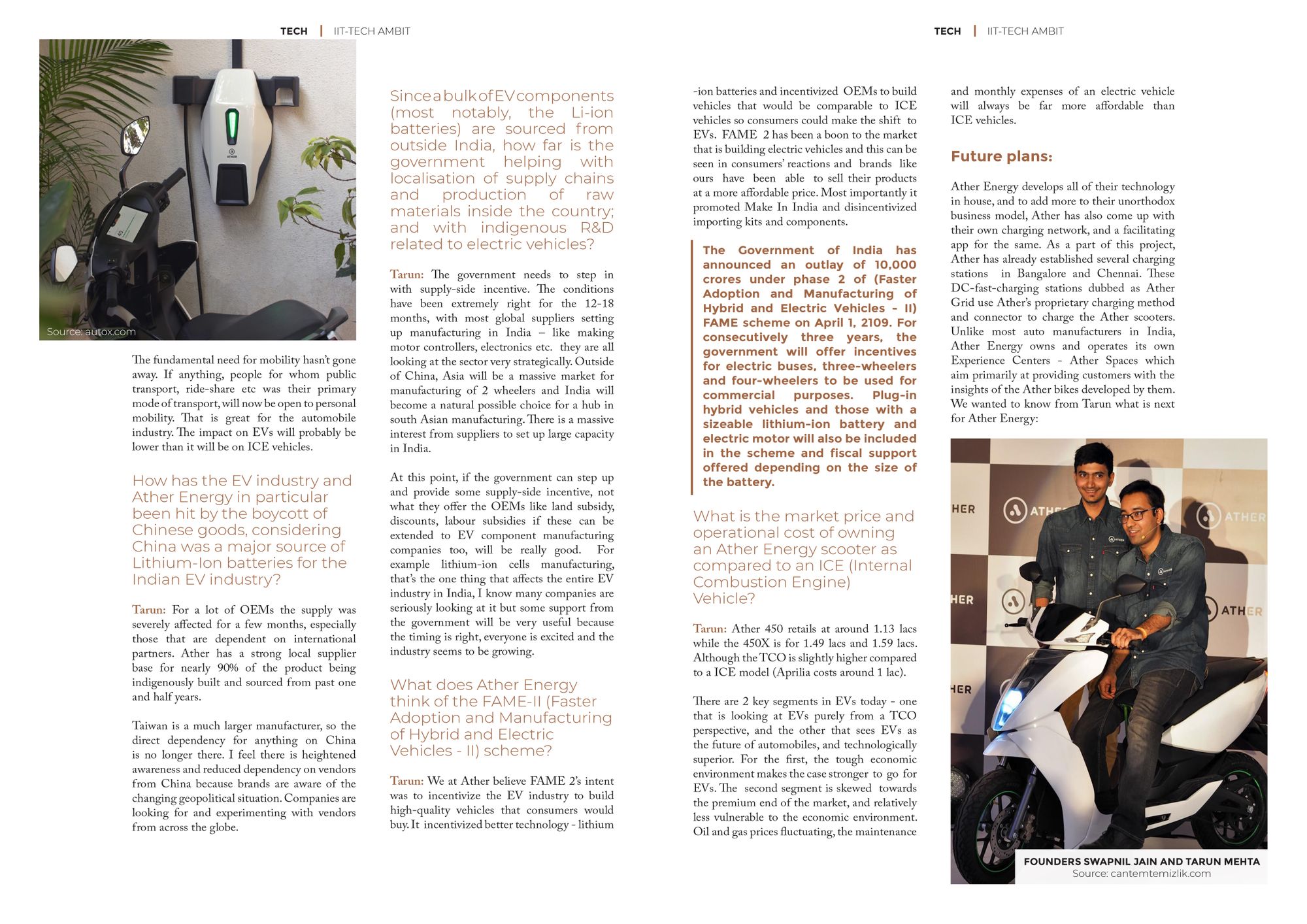
The Government of India has announced an outlay of ₹10,000 crores under phase 2 of (Faster Adoption and Manufacturing of Hybrid and Electric Vehicles - II) FAME scheme on April 1, 2109. For consecutively three years, the government will offer incentives for electric buses, three-wheelers and four-wheelers to be used for commercial purposes. Plug-in hybrid vehicles and those with a sizeable lithium-ion battery and electric motor will also be included in the scheme and fiscal support offered depending on the size of the battery.
What does Ather Energy think of the FAME-II (Faster Adoption and Manufacturing of Hybrid and Electric Vehicles - II) scheme?
Tarun: We at Ather believe FAME 2's intent was to incentivize the EV industry to build high-quality vehicles that consumers would buy. It incentivized better technology - lithium-ion batteries and incentivized OEMs to build vehicles that would be comparable to ICE vehicles so consumers could make the shift to EVs. FAME 2 has been a boon to the market that is building electric vehicles and this can be seen in consumers' reactions and brands like ours have been able to sell their products at a more affordable price. Most importantly it promoted Make In India and disincentivized importing kits and components.
What is the market price and operational cost of owning an Ather Energy scooter as compared to an ICE (Internal Combustion Engine) Vehicle?
Tarun: Ather 450 retails at around 1.13 lacs while the 450X is for 1.49 lacs and 1.59 lacs. Although the TCO is slightly higher compared to a ICE model (Aprilia costs around 1 lac)
There are 2 key segments in EVs today - one that is looking at EVs purely from a TCO perspective, and the other that sees EVs as the future of automobiles, and technologically superior. For the first, the tough economic environment makes the case stronger to go for EVs. The second segment is skewed towards the premium end of the market, and relatively less vulnerable to the economic environment.
Oil and gas prices fluctuating, the maintenance and monthly expenses of an electric vehicle will always be far more affordable than ICE vehicles.
Future plans:
Ather Energy develops all of their technology in house, and to add more to their unorthodox business model, Ather has also come up with their own charging network, and a facilitating app for the same. As a part of this project, Ather has already established several charging stations in Bangalore and Chennai. These DC-fast-charging stations dubbed as Ather Grid use Ather's proprietary charging method and connector to charge the Ather scooters. Unlike most auto manufacturers in India, Ather Energy owns and operates its own Experience Centers - Ather Spaces which aim primarily at providing customers with the insights of the Ather bikes developed by them. We wanted to know from Tarun what is next for Ather Energy:
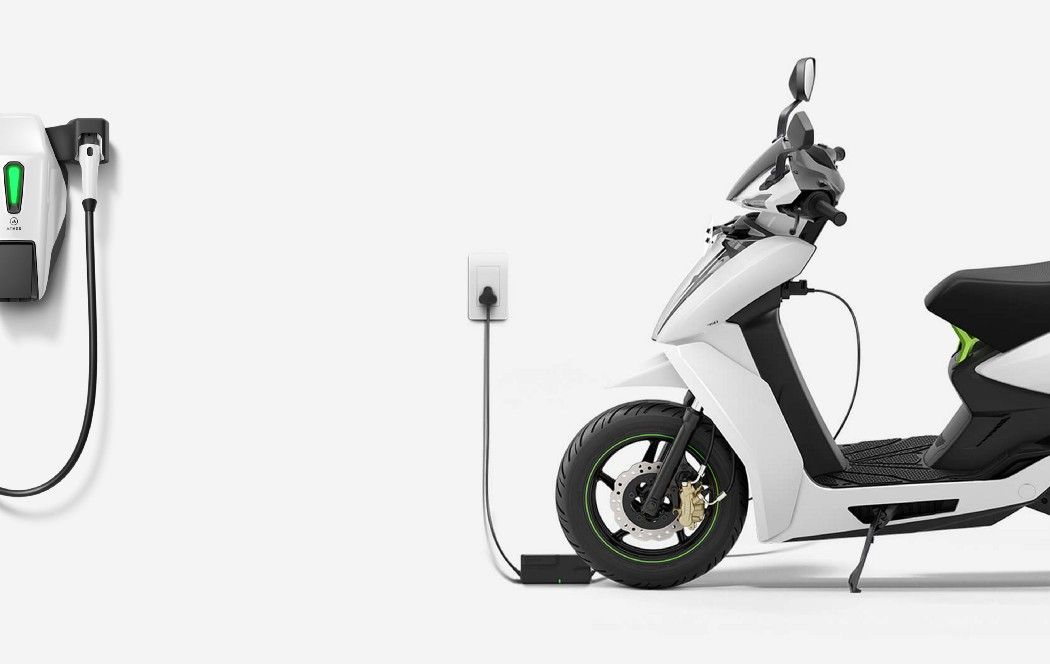
How far are we as a country from achieving electric mobility on our roads, and where does Ather Energy see itself in India’s electric future?
Tarun: One of the best things to happen with the pandemic is people have now realised the importance of a clean and green environment, and have witnessed the quick results that can be seen with reduced air pollution. The transport industry can only reduce air pollution by making a systematic shift to electric mobility, this will drive the transition in India.
The year 2019 was one of the worst years for the traditional automobile industry with falling sales and piling inventory. Passenger vehicle sales declined by 17.98 per cent in April-November 2019 over the same period last year, according to the Society of Indian Automobile Manufacturers (SIAM). In a way, the industry was struggling even before the pandemic unlike the EV industry, which saw a 20% increase in sales. With new and existing brands launching more efficient and powerful electric two-wheelers that are near-equal or better in performance than their ICE counterparts, electric vehicles will definitely be the future of mobility in India.
The pandemic may have disrupted our timelines for the national launch of the 450X, but not our spirit. We will be starting deliveries of the 450X starting next month in a phased manner across all the 10 cities we announced early this year. By Q1 of 2021 Ather 450 will be on roads in Mumbai, Delhi, Chennai, Bengaluru, Hyderabad, Coimbatore, Kochi. Ahmedabad, Pune, and Nagpur.
Does Ather Energy have any plans of coming up with other products (Electric Cars, or electric motorbikes) than the electric scooters currently being made?
Tarun: Not at the moment
Are there any plans for producing new and unorthodox products that further improve the rider’s experience (for example, smart helmets) anytime soon?
Tarun: We plan to roll out a Tyre Pressure Monitoring System (TPMS) soon and offer a smart helmet option by the end of March 2021. These features are designed to exploit the scooter's connected tech features.
Ather Energy started off with Tarun Mehta and Swapnil Jain developing Battery packs. Did you (at least initially) have any plans of expanding into the energy sector, and do you still have any such future plans?
Tarun: Currently, all our energies are into launching the 450X nationally
As I'm finishing this article, I can only think of one way to wrap up this series on Ather Energy - how it has taught me what true engineering and entrepreneurial virtues are. In just a couple of months time, engineering campuses all over India and IITs specifically will again be teeming with enthusiastic first year students (at least in online classrooms, if not physically) ready to take on the world with their ideas. And if there is one message that they need to imbibe, is that the road to success today is not the oft quoted 'stable' engineering career - but rather, it starts from daring to explore new possibilities, and goes forward with vision, hard work and astute knowledge of one's field of expertise. And what better example of that than Ather Energy itself!
